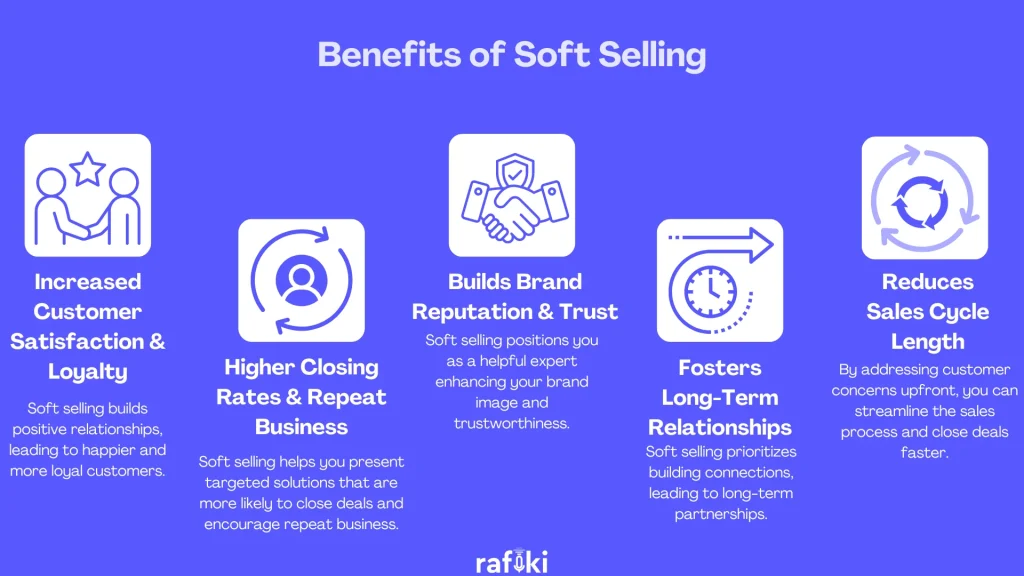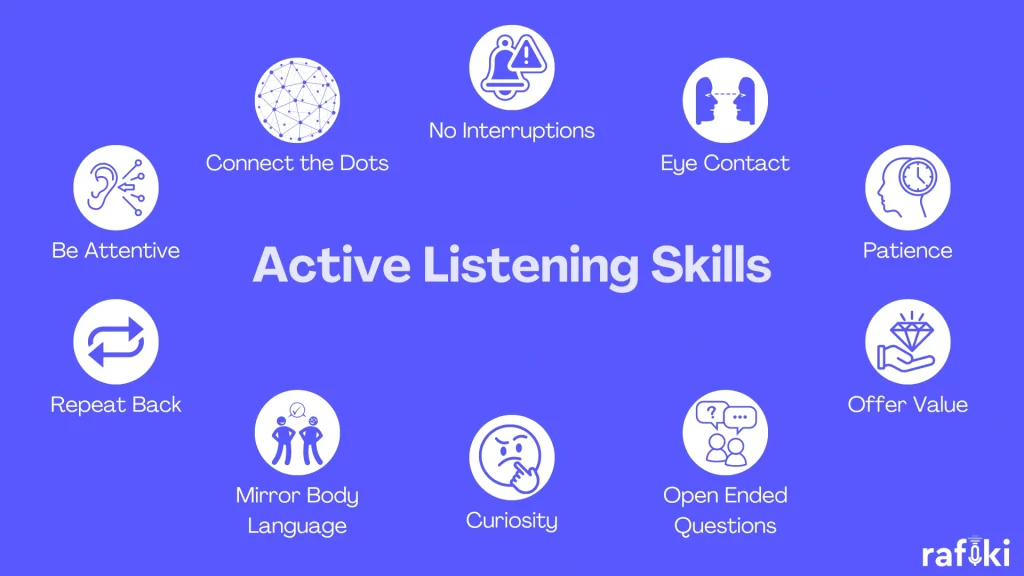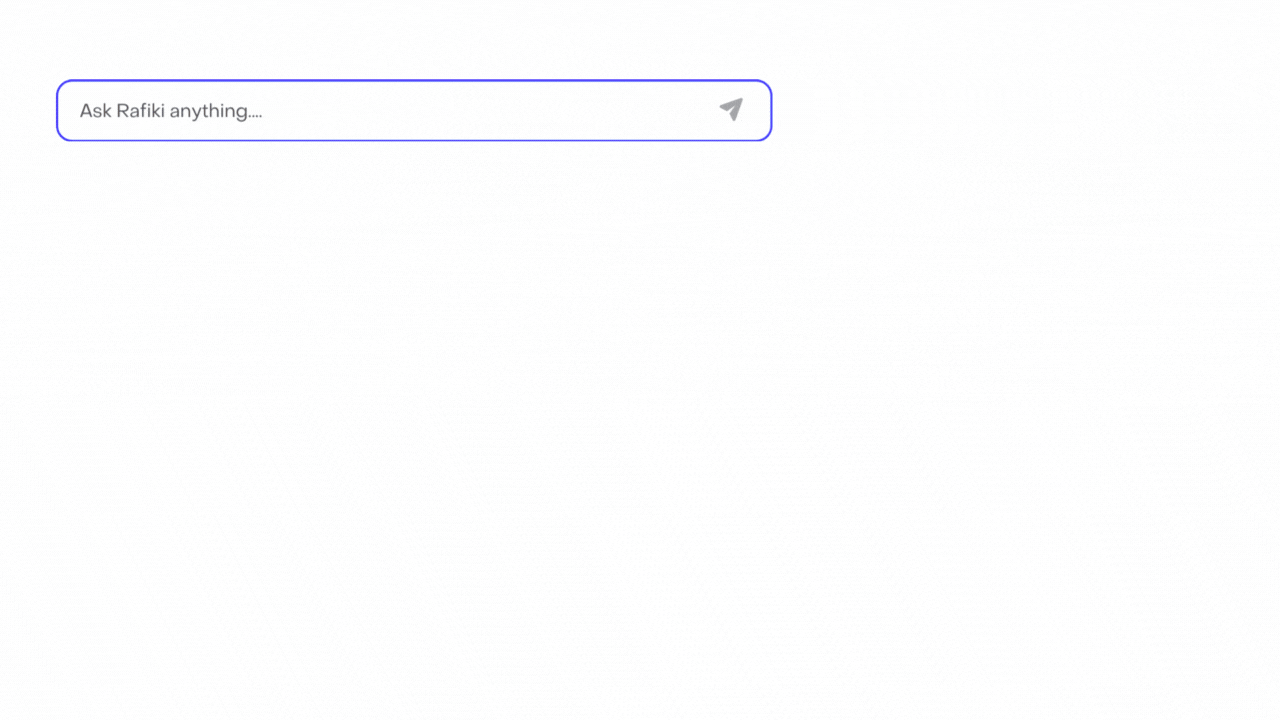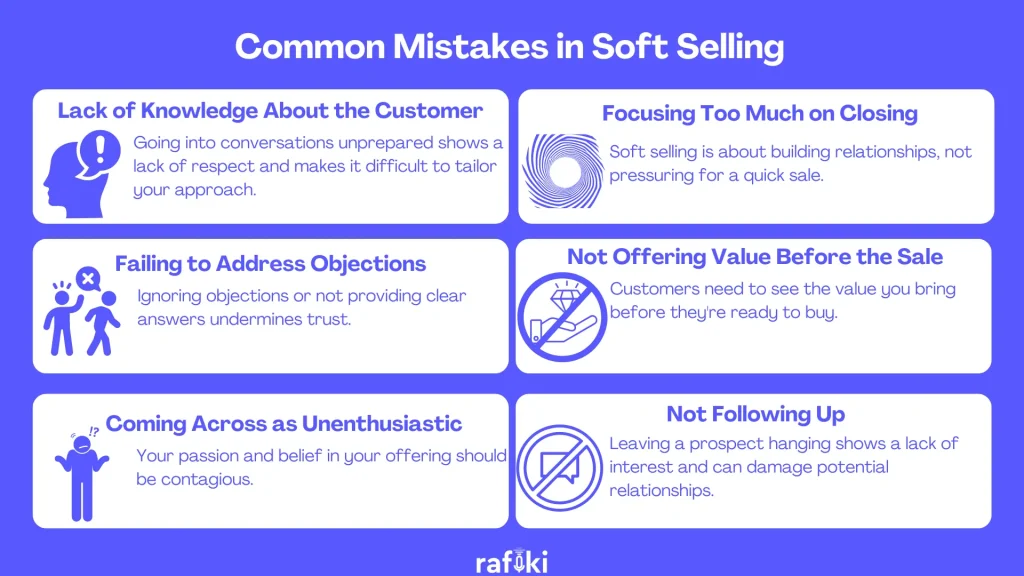Why Rafiki
Pricing


Pricing
Solutions

RevOps Leaders
Synchronize revenue generating functions

SDR Leaders
Get your team aligned and Coach your Reps 3x faster at scale

Sales Leaders
Unlock pipeline truth, drive confident forecasts

In today's competitive sales landscape, the old-school "hard sell" tactics just don't cut it anymore. Customers are savvier and do their research before making a purchase. They're looking for genuine connections and solutions that address their specific needs. That's where soft selling comes in.
Soft selling is a relationship-focused sales approach that prioritizes building trust and understanding customer pain points over aggressive persuasion. It's about creating a win-win situation where both the customer and the salesperson walk away satisfied.
Let’s dive in!
Soft selling isn't about pushing products or services down someone's throat. It's about establishing yourself as a trusted advisor and resource for your potential customers. So here's how it differs from the traditional hard sell:
By employing soft selling techniques, you can create a more positive and productive sales experience for both you and your prospects. Imagine this: instead of feeling pressured, your customers feel genuinely heard and understood. This fosters trust and makes them more receptive to your offerings.
Rafiki, a conversation intelligence platform, can actually help you with this by automatically summarizing calls with human-grade quality. So this frees you up to focus on actively listening and building rapport during your calls.

Soft selling isn't a one-size-fits-all approach, but it shines in certain situations. Here are some prime examples:
Even in situations where a hard sell might seem tempting, like nearing the end of a quarter, remember that soft selling often leads to better long-term results. By investing time in understanding your customers and building trust, you'll cultivate a loyal customer base that drives sustainable sales growth.
The foundation of soft selling is truly understanding your customer's needs. This is where active listening and asking insightful questions come into play.

What it is: Active listening goes beyond simply hearing what someone says. It involves paying close attention, asking clarifying questions, and demonstrating that you understand their perspective. Insightful questions are open-ended and delve deeper into the customer's challenges and goals.
Why it works: When you actively listen and ask insightful questions, it shows the customer that you're genuinely interested in them and their business. This builds trust and rapport. Moreover, by understanding their specific needs, you can tailor your pitch to address their unique challenges and demonstrate the value your product or service brings.
How to use it: Here's how to implement this technique:
Example (B2B): You're a sales rep for a marketing automation platform. Instead of launching into a product demo, you start by asking, "What are some of your biggest challenges with managing your current marketing campaigns?" This opens the door for the customer to share their pain points, allowing you to tailor your presentation to their specific needs.
Example (B2C): Imagine you sell high-end athletic shoes. A customer browsing running shoes mentions they're training for a marathon. An active listening approach would involve asking, "What are your goals for the marathon?" or "What kind of terrain will you be running on?" This allows you to recommend shoes that meet their specific needs and preferences.
Soft selling isn't about selling features; it's about selling the value those features bring to the customer's life.
What it is: This technique involves shifting the focus from your product or service to the problems it solves and the benefits it delivers. It's about demonstrating how your offering can make the customer's life or business easier, better, or more efficient.
Why it works: Customers are more likely to invest in something that solves a specific problem or helps them achieve a desired outcome. By focusing on value, you connect with their emotional needs and paint a clear picture of how your product or service improves their situation.
How to use it: Here's how to implement this technique:
Example (B2B): You're selling a project management software. Instead of highlighting features like task lists and deadlines, you focus on how it improves team collaboration, streamlines workflows, and helps businesses meet project deadlines on time and within budget.
Example (B2C): Imagine you sell a meal kit delivery service. The value proposition goes beyond just selling groceries. You focus on the convenience of pre-portioned ingredients, the time saved by not meal planning, and the variety of healthy recipes offered, all of which can simplify a busy lifestyle.
In today's information age, customers have access to a wealth of product information online. What they truly value is the expertise and guidance of a trusted advisor.
What it is: This technique positions you as a knowledgeable and reliable source of information within your industry. You're not just a salesperson; you're a consultant offering valuable insights and solutions.
Why it works: People are more likely to buy from someone they trust and respect. By establishing yourself as an expert, you build credibility and differentiate yourself from competitors who simply push products. Moreover, customers are more receptive to your recommendations when they see you as a genuine resource.
How to use it: Here are some ways to cultivate a trusted advisor persona:
Example (B2B): You're a sales rep for a cybersecurity company. Beyond selling security software, you offer free consultations to assess a company's current security posture and provide recommendations for improvement. This demonstrates your expertise and builds trust, making them more likely to choose you when they need security solutions.
Example (B2C): Imagine you're a financial advisor. Instead of solely focusing on selling investment products, you offer free consultations to discuss financial goals and provide personalized financial planning advice. This establishes you as a trusted advisor, making them more likely to turn to you for future financial needs.
Rafiki's Ask Rafiki Anything feature can be a goldmine for surfacing trends and insights from past conversations to strengthen your position as an expert.

People connect with stories. Soft selling capitalizes on this by using storytelling and social proof to build trust and illustrate the value you offer.
What it is: Storytelling involves weaving narratives that resonate with your customer's challenges and aspirations. Social proof highlights the positive experiences of existing customers through testimonials, case studies, or data.
Why it works: Stories tap into the emotional side of decision-making. By sharing relatable stories of how your product or service helped others, you make your offering come alive and leave a lasting impression. Social proof adds credibility by demonstrating the value you deliver to real customers.
How to use it: Here's how to leverage storytelling and social proof:
Example (B2B): You're selling a customer relationship management (CRM) platform. Share a story about how a client used your CRM to streamline their sales process and increase conversion rates by 20%. This data-driven story with a relatable outcome is powerful.
Example (B2C): Imagine you sell fitness trackers. Feature a customer testimonial video on your website showcasing how your tracker helped a user achieve their weight loss goals. Seeing a real person's success story builds trust and motivates potential customers.
Soft selling isn't about pushing a one-size-fits-all solution. It's about understanding each customer's unique needs and crafting personalized recommendations.
What it is: This technique involves actively listening to your customers, identifying their specific challenges, and then tailoring your approach to present solutions that directly address their needs.
Why it works: Customers appreciate feeling valued and understood. By taking the time to personalize your approach, you demonstrate genuine interest and increase the relevance of your offering. So, this makes them more receptive to your recommendations and more likely to see your product or service as the perfect fit.
How to use it: Here's how to implement a solution-oriented, tailored approach:
Example (B2B): You're selling a social media marketing software. Instead of offering a pre-packaged plan, you ask about the client's target audience, social media goals, and current challenges. Then, you tailor a proposal that highlights features that directly address their needs, showcasing a customized approach.
Example (B2C): Imagine you sell car insurance. Instead of a generic sales pitch, you ask a customer about their driving habits, car type, and desired coverage level. Then, you present personalized quotes and explain how different plans address their specific needs and budget.
Before you set off into the sunset with these techniques, here's a quick reminder of the common mistakes sales reps make while doing the soft sell:

Soft selling isn't just a sales tactic; it's a philosophy that prioritizes building trust and genuine connections. By implementing these techniques, you can transform your sales approach, cultivate loyal customers, and achieve sustainable success. Keep in mind, soft selling requires practice, patience, and the right tools.
Rafiki, with its conversation intelligence features, can be your secret weapon in mastering soft selling. Sign up for your free 14-day trial today and see how Rafiki can help you transform your sales conversations.
Master the Art of Soft Selling